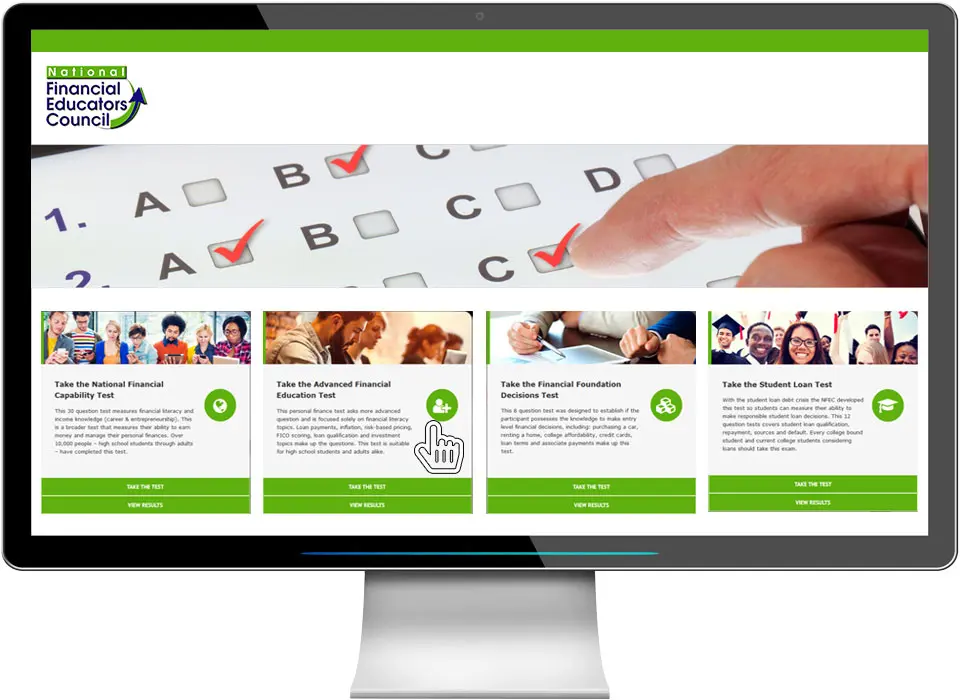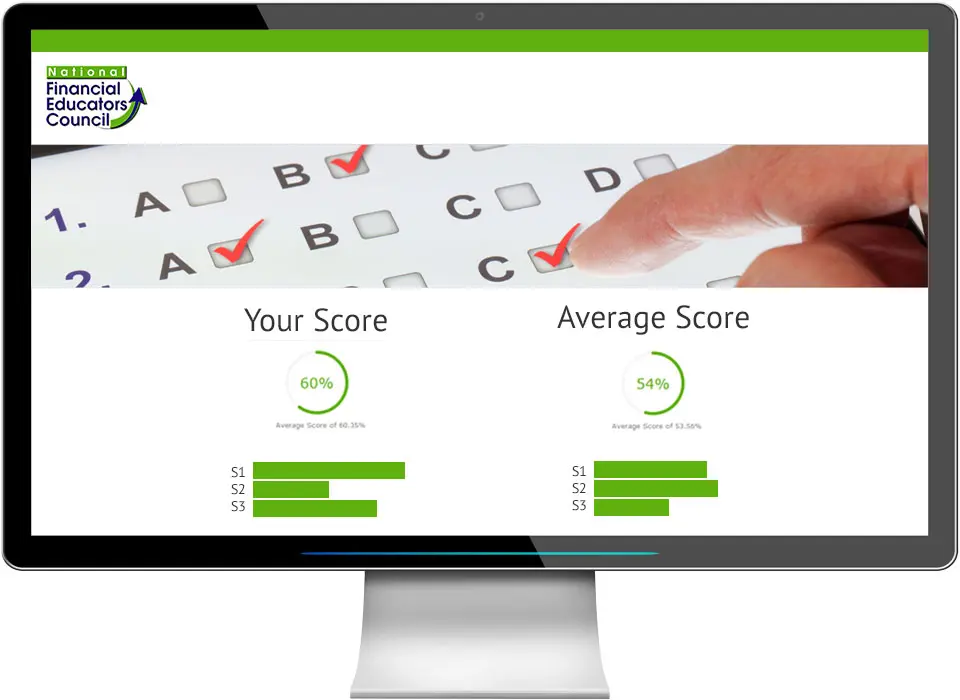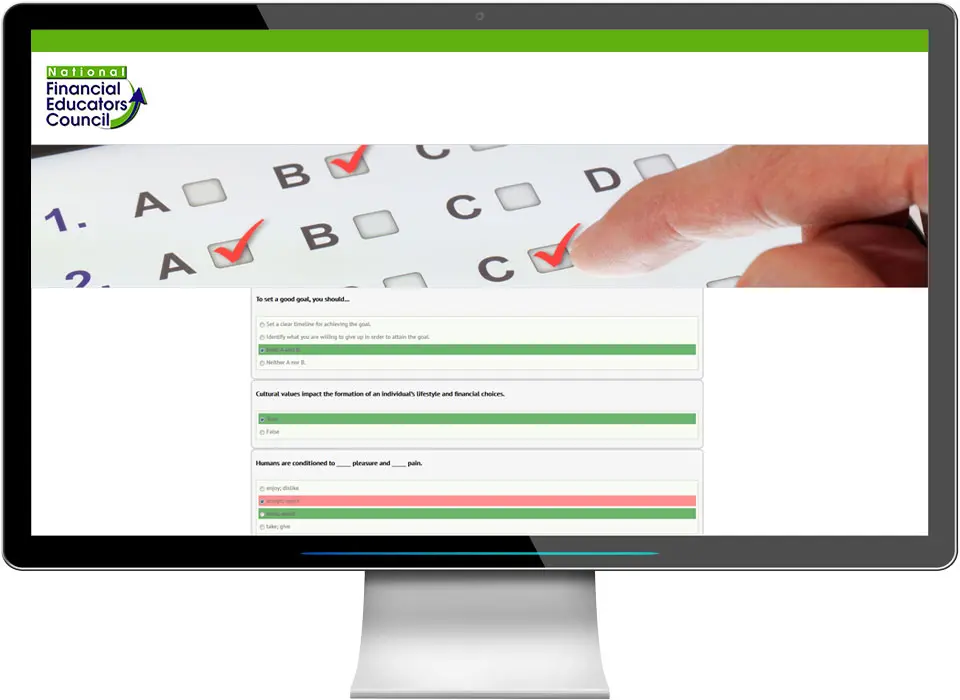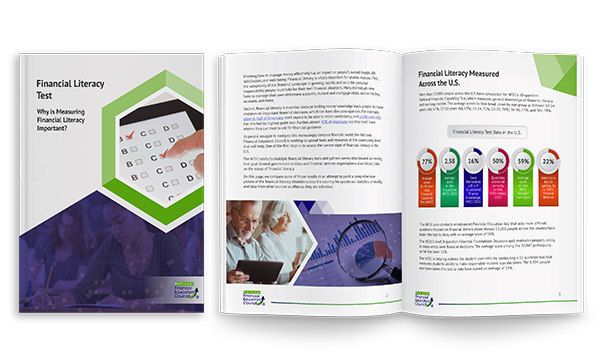Financial Literacy Test Center: National Test & 33 Other Complimentary Tests Completed by Over 160,000 People
The NFEC’s Financial Literacy Test Center provides complimentary tests and testing results. Organizations and individuals are welcome to use this online evaluation material for pre-and post-testing, self-assessment, and/or to gain a better understanding about various financial literacy topics.
The Center was developed with three objectives: providing resources for financial educators, offering tools for people interested in improving their financial knowledge, and giving the media up-to-date information about the current state of financial education. The data gathered using these resources will be used to help adapt NFEC programs to accommodate different learner needs.
The NFEC’s financial literacy test results have been featured in Huffington Post, The Hill, Yahoo Finance, Business Insider, MarketWatch, Forbes, CNBC and many major media outlets. More than 160,000 people from all 50 states participated in our financial literacy tests and surveys.
Why is Measuring Financial Literacy Important?
The NFEC conducts multiple financial literacy tests and gathers survey data toward achieving that goal. Several government entities and financial services organizations also collect data on the status of financial literacy.
In this document, we compare some of those results in an attempt to paint a comprehensive picture of the financial literacy situation across the country. We update our statistics annually, and data from other sources as often as they are refreshed.

Select & Take the Test
Select Test to Participate In – All Complimentary

Receive Results
Receive Immediate Results & Compare with Others

View & Learn
View the Questions, Correct Answers & Learn
Educators & Course Facilitators: Each student will receive results to them after they complete the test. To receive student results have them forward you their email.
*Tests and surveys provided may be used only on the NFEC website. Printing the tests or surveys is prohibited. Commercial use, sale, or any other use that violates the terms and conditions and copyright is prohibited.
Topic Based Tests
Average Score of the National Financial Literacy Test Segmented by Age
Over 100,000 people from all 50 states have completed the National Financial Literacy Test – a 30-question test designed to measure participants’ ability to earn, save, and grow their money. The test questions cover the 10 subjects covered in the Financial Literacy Framework & Standards and were written to measure 3 key areas: motivation to learn, subject knowledge, and recognition of the first step.
Although the National Financial Literacy Test was specifically designed for 15- to 18-year-olds, people of all ages have taken part in this assessment. See details below – for the latest national financial literacy test results click here.
10 – 14
Years of Age
Average Score of 56.53%
15 – 18
Years of Age
Average Score of 64.21%
19 – 24
Years of Age
Average Score of 70.66%
25 – 35
Years of Age
Average Score of 75.95%
36 – 50
Years of Age
Average Score of 77.03%
51+
Years of Age
Average Score of 77.82%
Financial Literacy Test Question Features
The NFEC’s financial education test measures each of the 10 areas covered within the financial literacy standards. These topics include: Financial Psychology, Credit & Debt, Accounts & Budgeting, Skill Growth, Income, Business Relations, Long-term Planning, Risk Management, Investments, and Social Enterprise.
The NFEC’s National Financial Literacy Test measures each of the aforementioned subjects and breaks the test down into three distinct areas that affect one’s financial capability.
Sample Question & Results:
How can understanding risk management topics help me in everyday life?
Sample Question & Results:
From the following list, choose the two best suggestions for building and maintaining a good credit rating.
Sample Question & Results:
How do I begin the process of creating a long-term financial plan?
Those Conducting Financial Education Programs are Encouraged to Measure Impact
The NFEC recognizes the importance of measuring all the elements that go into developing a successful financial literacy campaign. Measuring these three areas enables the design of a comprehensive financial education initiative that will maximize participant results.
Conducting financial literacy tests can help your organization evaluate your financial education program and its instructors and have a direct impact on your funding. Administering testing before and after your financial literacy program is an important part of developing a sustainable campaign.
The NFEC includes quizzes and tests with their entire financial literacy curriculum (free lesson plans) and events. In addition, the NFEC offers customized financial literacy testing, measurement, and long-term studies that measure changes in behavior.
With comprehensive pre- and post-testing, your organization stands a better chance of receiving financial literacy funding. This may help your organization sustain your programs and reach more people with the training. Gathering quantitative data can measure students’ understanding and the overall effectiveness of your financial education program. Learn more about the National Financial Educators Council’s tests that are included in our curriculum and financial literacy programs.
To learn more about the National Financial Educators Council’s financial literacy tests, complete the form located on the ‘Contact Us’ or ‘Solution Center’ page.
National Media Coverage of NFEC Testing & Surveys
Financial literacy gaps could be costing you more than you think. Asked to put a dollar figure on how much money they have lost in their lifetime due to personal finance missteps, nearly 25 percent of consumers estimated the cost at $30,000 or more, according to a new survey from the National Financial Educators Council. (The group polled 3,006 adults in mid-March.) More than a third put their losses at $999 or less.
Respondents Losing $30,000 or more; Sample Size
Over the course of a little over three years, the National Financial Educator’s Council administered a national financial literacy test to 4,916 youth between the ages of 15 and 18, from more than 40 states in the United States. The average score was 60.08 percent. In any standard “classroom” 60.08 percent would be a failing grade.
Participants from 40 States & Sample Size
A financial literacy test given by the National Financial Educator’s Council found that test-takers from 15-18 years old scored an average of only 59.6%. No matter what they’re learning in school, most young Americans are lost when it comes to managing their money.
National Financial Literacy Test Average Score & Sample Size
Despite their efficacy, a small portion of employers have been using pre-employment screenings. Only a quarter of job applicants said an employer checked their financial background and 5% were rejected from a job due to their financial profile, according to a survey of 1,165 U.S. workers by the National Financial Educators Council, a financial education company. [Employee Financial Wellness]
Survey Response & Sample Size
According to the results of a 2014 National Financial Educator’s Council’s survey, only 58 percent of America’s high school students passed a basic financial literacy test. The same study found that 96 percent of respondents would have made different decisions pertaining to their higher education if they were more aware of the repayment process.
Survey Accompanying the National Financial Literacy Test Score
29 Money Lessons Every High School Graduate Should Know. A financial literacy test given by the National Financial Educator’s Council found that test-takers from 15-18 years old scored an average of only 59.6%.
National Financial Literacy Test Average Score & Sample Size
You know your teens can be illogical, unreasonable, and occasionally malodorous, but isn’t it at least reasonable to assume they know the basics about money? Apparently not. Surveys [National Financial Educators Council] show that teens are failing at financial literacy. And while financial institutions like PricewaterhouseCoopers are investing significant resources in changing that, the problem is persisting.
The National Financial Educators Council (NFEC) released their report from the National Financial Literacy Test and the results were depressing. The NFEC surveyed 11,000 people from all 50 states and the average score from 15- to 18-year-olds was 60.35%.
National Financial Literacy Test Average Score & Sample Size
Trade Industry Coverage of NFEC Testing & Surveys

Data through February 2014 from the National Financial Educators Council’s (NFEC) National Financial Literacy Test, which tests youth between 15 and 18 on the areas covered within national financial literacy standards, reveals that: 115 (4.7%) participants achieved a score at or above 90%. 271 (11%) achieved a score at or above 80%. 539 (21.9%) achieved a score at or above 70%. 1,534 (62.4%) participants scored at or under 69.9%.

96% of adults agree that kids under 21 years old should be required to take a personal finance course. The National Financial Educators Council’s Financial Literacy Test – the average score was 60%.(/p>
While you may think this is an unlikely scenario, a recent survey by the National Financial Educators Council shows this is sadly a trend. It found that more than five percent of job hunters have been turned down from a position because of their financial situation.

The National Financial Educators Council found 19-24 year olds have low financial literacy. Fifty-one percent believe a personal finance class in high school would have helped them prepare for life. Whether there is a formal class or not, parents can help children understand that bills, budgets and payments recur every month—and the money has to come from somewhere.
“…the National Financial Educators Council (NFEC) have used surveys to collect information related to the level of understanding on financial topics. Surveys provide for anonymity as well as consistency as each respondent receives the same questions. Surveys allow for the acquisition of specific measurable data and comparison of that data across target populations. The results of a well-designed survey clearly answer a specific question. Surveys that answer the same question over a period of time also create opportunity to measure effectiveness of education.
Local News Coverage of NFEC Financial Literacy Tests & Surveys
AL.Com
A recent survey asked 1,100 young men and women ages 18 to 24 what high school courses would have benefited their lives most. Just over half – 51.4 percent – answered they think learning more about how to manage money would be more valuable to them than any of the other choices. The survey was co-sponsored by the National Financial Educators Council (NFEC), DreamCatcher Wealth Management, and The Minerva Foundation.
Fox 13
Surveys conducted by the National Financial Educators Council fond teaching money management in school has a big impact on students’ attitudes towards money and their budgeting behaviors later in life. And a new Bank of America USA Today survey shows just 30-percent of respondents thought their high school education did a good job teaching good financial habits.
Washington’s Top News
The National Financial Educators Council recently surveyed adults 35 to 54 years old about their experience in the hiring process. Among the 1,200 people who responded to the nationwide poll, 5.2 percent said they had been turned down for a job because of their financial profile. When asked if their employer ever conducted a credit of financial background check as a condition of being hired or getting a promotion, 26.3 percent said yes.
Savannah CEO
Another interesting finding was that, among people residing in urban areas, those who earned between $50,000 and $74,000 per year were more likely to choose “money management” as the most beneficial course than did those earning $25-49,000 annually. This research was sponsored by the collaborative efforts of the NFEC, DreamCatcher Wealth Management, and The Minerva Foundation for Financial Literacy.




















